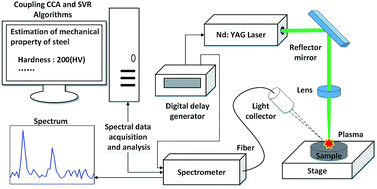当前位置:
X-MOL 学术
›
J. Anal. At. Spectrom.
›
论文详情
Our official English website, www.x-mol.net, welcomes your feedback! (Note: you will need to create a separate account there.)
Estimation of the mechanical properties of steel via LIBS combined with canonical correlation analysis (CCA) and support vector regression (SVR)
Journal of Analytical Atomic Spectrometry ( IF 3.4 ) Pub Date : 2018-03-06 00:00:00 , DOI: 10.1039/c8ja00030a Jianwei Huang 1, 2, 3, 4, 5 , Meirong Dong 1, 2, 3, 4, 5 , Shengzi Lu 1, 2, 3, 4, 5 , Wenbing Li 1, 2, 3, 4, 5 , Jidong Lu 1, 2, 3, 4, 5 , Chunyi Liu 6, 7, 8 , Jong H. Yoo 6, 7, 8
Journal of Analytical Atomic Spectrometry ( IF 3.4 ) Pub Date : 2018-03-06 00:00:00 , DOI: 10.1039/c8ja00030a Jianwei Huang 1, 2, 3, 4, 5 , Meirong Dong 1, 2, 3, 4, 5 , Shengzi Lu 1, 2, 3, 4, 5 , Wenbing Li 1, 2, 3, 4, 5 , Jidong Lu 1, 2, 3, 4, 5 , Chunyi Liu 6, 7, 8 , Jong H. Yoo 6, 7, 8
Affiliation

|
Degradation of steel is a significant issue in the field of material aging, with the mechanical properties of steel degrading during service, affecting the safety of equipment. In this work, laser-induced breakdown spectroscopy (LIBS) was applied to investigate the mechanical properties of steel. T91 steel specimens with different degrees of microstructure aging were selected as model samples. Surface hardness was chosen as the key indicator of mechanical properties. The correlation between emission line intensity and hardness was analyzed in order to establish a calibration model of hardness. Multivariate analysis methods (principal component analysis [PCA] and canonical correlation analysis [CCA]) were introduced to identify the important variables from the whole spectrum. Then, two regression algorithms (partial least-squares regression [PLSR] and support vector regression [SVR]) were used to establish the calibration models with the selected variables. The results showed that it is feasible to couple CCA and SVR to estimate hardness, which can effectively identify the correlated variables and establish the correlation between emission lines and hardness, with maximum values for mean relative error (MRE), relative standard deviation (RSD) and root mean square error of prediction (RMSEP) of 2.47%, 2.94% and 6.14, respectively. In addition, the influence of collinearity variables on the established model was investigated in order to show that there is little multicollinearity issue in the calibration models constructed with CCA and SVR according to the values of RMSEP, RSD and MRE. This demonstrates that LIBS technology coupled with chemometrics (CCA and SVR) is an appropriate method to estimate the mechanical properties of steel.
中文翻译:

通过LIBS结合规范相关分析(CCA)和支持向量回归(SVR) 估算钢的力学性能
钢的降解是材料老化领域中的一个重要问题,在使用过程中钢的机械性能会下降,从而影响设备的安全性。在这项工作中,激光诱导击穿光谱法(LIBS)用于研究钢的机械性能。选择具有不同显微组织时效程度的T91钢样本作为模型样本。选择表面硬度作为机械性能的关键指标。分析了发射线强度和硬度之间的相关性,以建立硬度的校准模型。引入了多变量分析方法(主成分分析[PCA]和规范相关分析[CCA])来从整个光谱中识别出重要变量。然后,使用两种回归算法(偏最小二乘回归[PLSR]和支持向量回归[SVR])来建立具有所选变量的校准模型。结果表明,结合CCA和SVR估算硬度是可行的,它可以有效地识别相关变量,并建立发射谱线与硬度之间的相关性,并且具有平均相对误差(MRE),相对标准偏差(RSD)的最大值预测的均方根误差(RMSEP)分别为2.47%,2.94%和6.14。此外,研究了共线性变量对建立的模型的影响,以表明根据RMSEP,RSD和MRE的值,使用CCA和SVR构建的校准模型中几乎没有多重共线性问题。
更新日期:2018-03-06
中文翻译:

通过LIBS结合规范相关分析(CCA)和支持向量回归(SVR) 估算钢的力学性能
钢的降解是材料老化领域中的一个重要问题,在使用过程中钢的机械性能会下降,从而影响设备的安全性。在这项工作中,激光诱导击穿光谱法(LIBS)用于研究钢的机械性能。选择具有不同显微组织时效程度的T91钢样本作为模型样本。选择表面硬度作为机械性能的关键指标。分析了发射线强度和硬度之间的相关性,以建立硬度的校准模型。引入了多变量分析方法(主成分分析[PCA]和规范相关分析[CCA])来从整个光谱中识别出重要变量。然后,使用两种回归算法(偏最小二乘回归[PLSR]和支持向量回归[SVR])来建立具有所选变量的校准模型。结果表明,结合CCA和SVR估算硬度是可行的,它可以有效地识别相关变量,并建立发射谱线与硬度之间的相关性,并且具有平均相对误差(MRE),相对标准偏差(RSD)的最大值预测的均方根误差(RMSEP)分别为2.47%,2.94%和6.14。此外,研究了共线性变量对建立的模型的影响,以表明根据RMSEP,RSD和MRE的值,使用CCA和SVR构建的校准模型中几乎没有多重共线性问题。



























 京公网安备 11010802027423号
京公网安备 11010802027423号